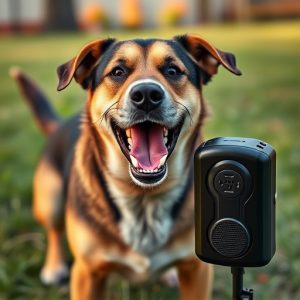Adjusting Sonic Repellent Training Levels: A Guide for Effective Animal Control
Sonic repellent systems use high-frequency sound waves to deter animals humanely. Adjusting training…….
Sonic repellent systems use high-frequency sound waves to deter animals humanely. Adjusting training levels is key, involving setting specific frequency ranges and intensity levels for targeted species while minimizing distress to humans and pets. Regular environmental assessments, maintenance, and adherence to manufacturer guidelines ensure optimal system performance and effectiveness against pests like rodents, birds, and insects.
Animal control has entered a new era with sonic repellent systems, offering a non-lethal approach to keeping pests at bay. Understanding how these devices use sound waves to deter animals is key to their effective implementation. This article delves into the science behind sonic repellents and provides a comprehensive guide on adjusting training levels. We’ll explore common animal sensitivities and offer insights on successful system implementation and maintenance, helping you harness the power of sound for efficient wildlife management.
- Understanding Sonic Repellents: How They Work
- Adjusting Training Levels: A Step-by-Step Guide
- Common Animals and Their Sensitivity to Sound
- Implementing and Maintaining the System Effectively
Understanding Sonic Repellents: How They Work
Sonic repellent systems have emerged as a humane and effective way to deter animals from specific areas. These devices use high-frequency sound waves, often above the human hearing range, to create an unpleasant sensation for targeted animals. When activated, the system emits a series of ultrasonic pulses that animals perceive as a threat, encouraging them to leave the treated area. This technology is particularly useful in urban settings where traditional repellents might not be suitable or could cause harm to non-target species.
Adjusting the sonic repellent training levels is crucial for optimal performance and user experience. Different animal species have varying sensitivity to ultrasonic frequencies, so fine-tuning the settings ensures the system’s effectiveness while minimizing any potential distress to nearby humans or pets. Modern systems often come with adjustable frequency ranges and intensity levels, allowing users to tailor the repellents to specific needs. This flexibility enables efficient control of pests without causing unintended annoyance to bystanders.
Adjusting Training Levels: A Step-by-Step Guide
Adjusting the training levels on a sonic repellent system is a crucial step in ensuring its effectiveness and customization to your needs. Here’s a step-by-step guide to help you through this process.
1. Identify the Target Species: Begin by understanding which animals you want to deter. Different species are sensitive to specific sound frequencies, so knowing your target will allow you to set the appropriate training level. For example, bats and rodents might require higher frequency settings compared to larger mammals like deer or bears.
2. Access the Control Panel: Most sonic repellent systems have a control panel that can be accessed either via a mobile app or directly on the device itself. Navigate to the settings or training options.
3. Select Training Mode: Choose the “Adjust Training Levels” or a similar option. This mode allows you to fine-tune the system’s output intensity and frequency range.
4. Set Frequency Range: Adjust the lower and upper frequency limits based on your target species’ sensitivity. For instance, set a range that targets rodents (typically 20-50 kHz) if you’re dealing with squirrels or rats.
5. Adjust Volume/Intensity: Control the volume or intensity level to find what’s effective but not excessively loud, which could potentially harm non-target animals or humans. Start at a lower setting and gradually increase until the targeted species are deterred without causing discomfort.
6. Test and Adjust: Deploy the system in areas where the target animals have been spotted and monitor its performance. Observe their behavior; if they seem unaffected, consider increasing the intensity or frequency. If it’s too distressing for non-target species, reduce the settings.
Common Animals and Their Sensitivity to Sound
Animals, from rodents to birds and even insects, possess an acute sense of hearing, making them susceptible to sonic repellents. The effectiveness of sound as a deterrent is based on each species’ specific sensitivity to certain frequencies. For instance, high-frequency sounds above 20 kHz are often ineffective for larger animals like cats and dogs but can be highly disturbing to smaller rodents. Adjusting the sonic repellent training levels involves understanding these sensitivities to target specific pests without causing distress to non-target animals or humans.
Different animal species have varying auditory thresholds and preferences, so customizing the sound parameters is crucial. By fine-tuning the frequency, intensity, and duration of the sonic signal, users can create a safe yet effective barrier against common pest animals like squirrels, raccoons, and birds. This approach ensures that the system remains humane while providing a reliable solution for property owners seeking to protect their spaces without resorting to harmful chemicals or traps.
Implementing and Maintaining the System Effectively
Implementing and maintaining an animal control sonic repellent system effectively requires a strategic approach. Once installed, regularly assess the environment to understand the system’s performance. This includes monitoring noise levels and observing the behavior of targeted animals. By adjusting the sonic repellent training levels based on these observations, you can ensure optimal results without causing discomfort or harm to non-target species.
Regular maintenance is key to keeping the system efficient. Check all components for wear and tear, replace batteries if necessary, and clean sensors to maintain their sensitivity. Additionally, stay updated with manufacturer guidelines for calibration and software updates, as these can enhance the system’s effectiveness and longevity.
Animals can be a nuisance in unwanted areas, but with an effective animal control sonic repellent system, you have a powerful tool at your disposal. By understanding how these devices work and adjusting the training levels accordingly, you can target specific species while minimizing distress to others. With proper implementation and maintenance, this non-lethal approach offers a humane solution for keeping pests at bay and enjoying a peaceful environment. Remember, when it comes to adjusting sonic repellent training levels, finding the right balance is key to success.


